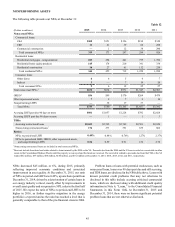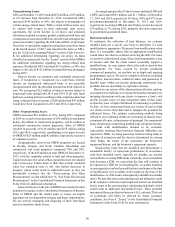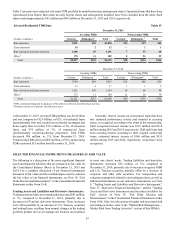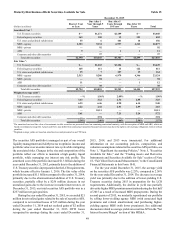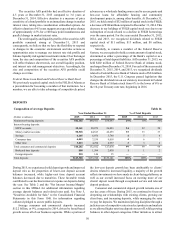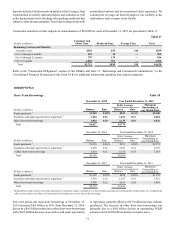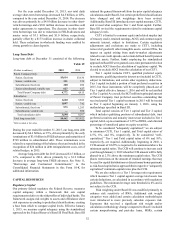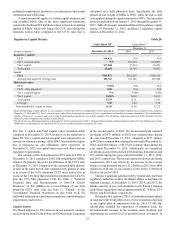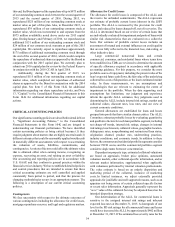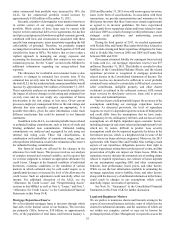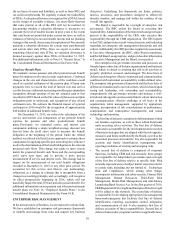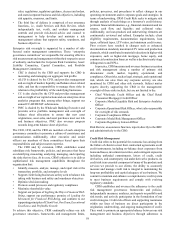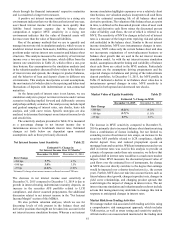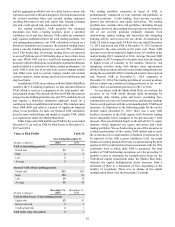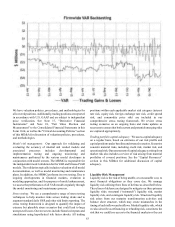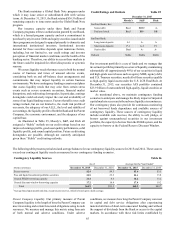SunTrust 2015 Annual Report Download - page 83
Download and view the complete annual report
Please find page 83 of the 2015 SunTrust annual report below. You can navigate through the pages in the report by either clicking on the pages listed below, or by using the keyword search tool below to find specific information within the annual report.55
entire commercial loan portfolio were increased by 10%, the
ALLL for the commercial portfolio would increase by
approximately $102 million at December 31, 2015.
Recently, a number of downgrades were made to borrowers
in certain sectors of our energy-related commercial loan
portfolio. While certain of these loans may be current with
respect to their contractual debt service agreements, the decline
in oil prices and projected slowdown in global economic growth,
combined with facts and circumstances associated with these
specific loan arrangements, raises uncertainty regarding the full
collectability of principal. Therefore, we prudently stopped
accruing interest on these loans in the fourth quarter of 2015 and
classified the loans as NPLs. We believe that we have taken a
vigilant approach to managing our energy exposure and
accounting for increased probable loss content in our reserve
estimation process. See the “Loans” section in this MD&A for
additional information regarding our energy-related loan
exposure.
The allowance for residential and consumer loans is also
sensitive to changes in estimated loss severity rates. If the
estimated loss severity rates for these loans increased by 10%,
the total ALLL for the residential and consumer portfolios would
increase by approximately $45 million at December 31, 2015.
These sensitivity analyses are intended to provide insights into
the impact of adverse changes in risk rating and estimated loss
severity rates and do not imply any expectation of future
deterioration in the risk ratings or loss rates. Given current
processes employed, management believes the risk ratings and
inherent loss rates currently assigned are appropriate. It is
possible that others, given the same information, could reach
different conclusions that could be material to our financial
statements.
In addition to the ALLL, we estimate probable losses related
to unfunded lending commitments, such as letters of credit and
binding unfunded loan commitments. Unfunded lending
commitments are analyzed and segregated by risk using our
internal risk rating scale. These risk classifications, in
combination with probability of commitment usage, and any
other pertinent information, result in the estimation of the reserve
for unfunded lending commitments.
Our financial results are affected by the changes in the
allowance for credit losses. This process involves our analysis
of complex internal and external variables, and it requires that
we exercise judgment to estimate an appropriate allowance for
credit losses. Changes in the financial condition of individual
borrowers, economic conditions, or the condition of various
markets in which collateral may be sold could require us to
significantly decrease or increase the level of the allowance for
credit losses. Such an adjustment could materially affect net
income. For additional discussion of the ALLL see the
“Allowance for Credit Losses” and “Nonperforming Assets”
sections in this MD&A as well as Note 6, “Loans,” and Note 7,
“Allowance for Credit Losses,” to the Consolidated Financial
Statements in this Form 10-K.
Mortgage Repurchase Reserve
We sell residential mortgage loans to investors through whole
loan sales in the normal course of our business. The investors
are primarily GSEs; however, $30 billion, or approximately
10%, of the population of total loans sold between January 1,
2005 and December 31, 2015 were sold to non-agency investors,
some in the form of securitizations. In association with these
transactions, we provide representations and warranties to the
third party investors that these loans meet certain requirements
as agreed to in investor guidelines. We have experienced
significantly fewer repurchase claims and losses related to loans
sold since 2009 as a result of stronger credit performance, more
stringent credit guidelines, and underwriting process
improvements.
During the third quarter of 2013, we reached agreements
with Freddie Mac and Fannie Mae under which they released us
from certain existing and future repurchase obligations for loans
sold to Freddie Mac between 2000 and 2008 and Fannie Mae
between 2000 and 2012.
Our current estimated liability for contingent losses related
to loans sold (i.e., our mortgage repurchase reserve) was $57
million at December 31, 2015. The liability is recorded in other
liabilities in the Consolidated Balance Sheets, and the related
repurchase provision is recognized in mortgage production
related income in the Consolidated Statements of Income. The
current reserves are deemed to be sufficient to cover probable
estimated losses related to certain defects (MI related, excessive
seller contribution, ineligible property, and other charter
violations) as outlined in the settlement contract, GSE owned
loans serviced by third party servicers, loans sold to private
investors, and indemnifications.
Various factors could potentially impact the accuracy of the
assumptions underlying our mortgage repurchase reserve
estimate. As discussed previously, the level of repurchase
requests we receive is dependent upon the actions of third parties
and could differ from the assumptions that we have made.
Delinquency levels, delinquency roll rates, and our loss severity
assumptions are all highly dependent upon economic factors,
including changes in real estate values and unemployment levels
which are, by nature, difficult to predict. Loss severity
assumptions could also be impacted negatively by delays in the
foreclosure process, which is a heightened risk in some of the
states where our loans sold were originated. Moreover, the 2013
agreements with Fannie Mae and Freddie Mac settling certain
aspects of our repurchase obligations preserve their right to
require repurchases arising from certain types of events, and that
preservation of rights can impact our future losses. While the
repurchase reserve includes the estimated cost of settling claims
related to required repurchases, our estimate of losses depends
on our assumptions regarding GSE and other counterparty
behavior, loan performance, home prices, and other factors.
While we use the best information available in estimating the
mortgage repurchase reserve liability, these, and other factors,
along with the discovery of additional information in the future,
could result in changes in our assumptions which could
materially impact our results of operations.
See Note 16, “Guarantees” to the Consolidated Financial
Statements in this Form 10-K for further discussion.
Legal and Regulatory Matters
We are parties to numerous claims and lawsuits arising in the
course of our normal business activities, some of which involve
claims for substantial amounts, and the outcomes of which are
not within our complete control or may not be known for
prolonged periods of time. Management is required to assess the


